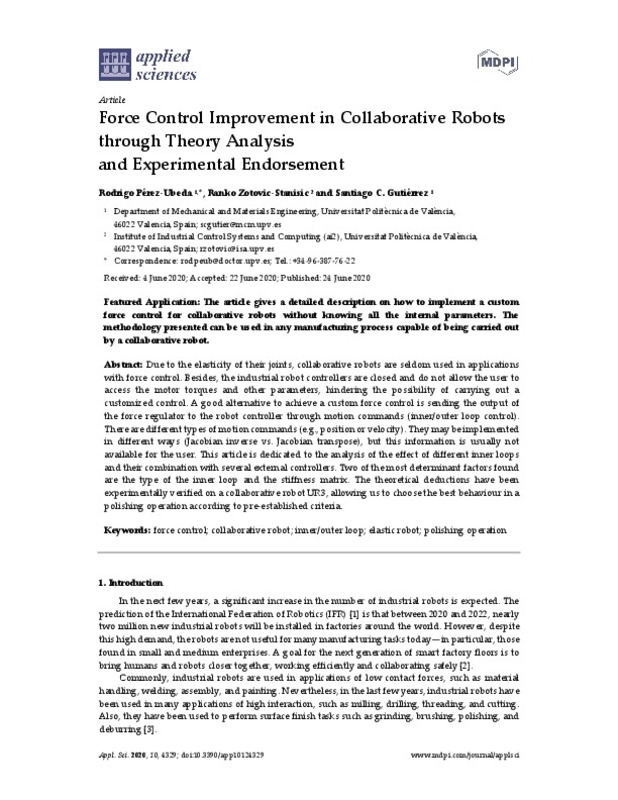Top Trends Robotics 2020—International Federation of Robotics https://ifr.org/ifr-press-releases/news/top-trends-robotics-2020
Gaz, C., Magrini, E., & De Luca, A. (2018). A model-based residual approach for human-robot collaboration during manual polishing operations. Mechatronics, 55, 234-247. doi:10.1016/j.mechatronics.2018.02.014
Iglesias, I., Sebastián, M. A., & Ares, J. E. (2015). Overview of the State of Robotic Machining: Current Situation and Future Potential. Procedia Engineering, 132, 911-917. doi:10.1016/j.proeng.2015.12.577
[+]
Top Trends Robotics 2020—International Federation of Robotics https://ifr.org/ifr-press-releases/news/top-trends-robotics-2020
Gaz, C., Magrini, E., & De Luca, A. (2018). A model-based residual approach for human-robot collaboration during manual polishing operations. Mechatronics, 55, 234-247. doi:10.1016/j.mechatronics.2018.02.014
Iglesias, I., Sebastián, M. A., & Ares, J. E. (2015). Overview of the State of Robotic Machining: Current Situation and Future Potential. Procedia Engineering, 132, 911-917. doi:10.1016/j.proeng.2015.12.577
Perez-Ubeda, R., Gutierrez, S. C., Zotovic, R., & Lluch-Cerezo, J. (2019). Study of the application of a collaborative robot for machining tasks. Procedia Manufacturing, 41, 867-874. doi:10.1016/j.promfg.2019.10.009
Spong, M. W. (1989). On the force control problem for flexible joint manipulators. IEEE Transactions on Automatic Control, 34(1), 107-111. doi:10.1109/9.8661
Ren, T., Dong, Y., Wu, D., & Chen, K. (2019). Impedance control of collaborative robots based on joint torque servo with active disturbance rejection. Industrial Robot: the international journal of robotics research and application, 46(4), 518-528. doi:10.1108/ir-06-2018-0130
Ajoudani, A., Tsagarakis, N. G., & Bicchi, A. (2017). Choosing Poses for Force and Stiffness Control. IEEE Transactions on Robotics, 33(6), 1483-1490. doi:10.1109/tro.2017.2708087
Magrini, E., & De Luca, A. (2016). Hybrid force/velocity control for physical human-robot collaboration tasks. 2016 IEEE/RSJ International Conference on Intelligent Robots and Systems (IROS). doi:10.1109/iros.2016.7759151
Ahmad, S. (1993). Constrained motion (force/position) control of flexible joint robots. IEEE Transactions on Systems, Man, and Cybernetics, 23(2), 374-381. doi:10.1109/21.229451
Calanca, A., & Fiorini, P. (2018). Understanding Environment-Adaptive Force Control of Series Elastic Actuators. IEEE/ASME Transactions on Mechatronics, 23(1), 413-423. doi:10.1109/tmech.2018.2790350
Oh, S., & Kong, K. (2017). High-Precision Robust Force Control of a Series Elastic Actuator. IEEE/ASME Transactions on Mechatronics, 22(1), 71-80. doi:10.1109/tmech.2016.2614503
Yin, H., Li, S., & Wang, H. (2016). Sliding mode position/force control for motion synchronization of a flexible-joint manipulator system with time delay. 2016 35th Chinese Control Conference (CCC). doi:10.1109/chicc.2016.7554329
Ma, Z., Hong, G.-S., Ang, M. H., Poo, A.-N., & Lin, W. (2018). A Force Control Method with Positive Feedback for Industrial Finishing Applications. 2018 IEEE/ASME International Conference on Advanced Intelligent Mechatronics (AIM). doi:10.1109/aim.2018.8452689
Huang, L., Ge, S. S., & Lee, T. H. (2006). Position/force control of uncertain constrained flexible joint robots. Mechatronics, 16(2), 111-120. doi:10.1016/j.mechatronics.2005.10.002
Chiaverini, S., Siciliano, B., & Villani, L. (1999). A survey of robot interaction control schemes with experimental comparison. IEEE/ASME Transactions on Mechatronics, 4(3), 273-285. doi:10.1109/3516.789685
Winkler, A., & Suchy, J. (2016). Explicit and implicit force control of an industrial manipulator — An experimental summary. 2016 21st International Conference on Methods and Models in Automation and Robotics (MMAR). doi:10.1109/mmar.2016.7575081
Neranon, P., & Bicker, R. (2016). Force/position control of a robot manipulator for human-robot interaction. Thermal Science, 20(suppl. 2), 537-548. doi:10.2298/tsci151005036n
Chen, S., Zhang, T., & Zou, Y. (2017). Fuzzy-Sliding Mode Force Control Research on Robotic Machining. Journal of Robotics, 2017, 1-8. doi:10.1155/2017/8128479
Lin, H.-I., & Dubey, V. (2018). Design of an Adaptive Force Controlled Robotic Polishing System Using Adaptive Fuzzy-PID. Advances in Intelligent Systems and Computing, 825-836. doi:10.1007/978-3-030-01370-7_64
Perez-Vidal, C., Gracia, L., Sanchez-Caballero, S., Solanes, J. E., Saccon, A., & Tornero, J. (2019). Design of a polishing tool for collaborative robotics using minimum viable product approach. International Journal of Computer Integrated Manufacturing, 32(9), 848-857. doi:10.1080/0951192x.2019.1637026
Chen, F., Zhao, H., Li, D., Chen, L., Tan, C., & Ding, H. (2019). Contact force control and vibration suppression in robotic polishing with a smart end effector. Robotics and Computer-Integrated Manufacturing, 57, 391-403. doi:10.1016/j.rcim.2018.12.019
Mohammad, A. E. K., Hong, J., & Wang, D. (2018). Design of a force-controlled end-effector with low-inertia effect for robotic polishing using macro-mini robot approach. Robotics and Computer-Integrated Manufacturing, 49, 54-65. doi:10.1016/j.rcim.2017.05.011
Xiao, C., Wang, Q., Zhou, X., Xu, Z., Lao, X., & Chen, Y. (2019). Hybrid Force/Position Control Strategy for Electromagnetic based Robotic Polishing Systems. 2019 Chinese Control Conference (CCC). doi:10.23919/chicc.2019.8865183
Li, J., Zhang, T., Liu, X., Guan, Y., & Wang, D. (2018). A Survey of Robotic Polishing. 2018 IEEE International Conference on Robotics and Biomimetics (ROBIO). doi:10.1109/robio.2018.8664890
Zollo, L., Siciliano, B., De Luca, A., Guglielmelli, E., & Dario, P. (2004). Compliance Control for an Anthropomorphic Robot with Elastic Joints: Theory and Experiments. Journal of Dynamic Systems, Measurement, and Control, 127(3), 321-328. doi:10.1115/1.1978911
Han, D., Duan, X., Li, M., Cui, T., Ma, A., & Ma, X. (2017). Interaction Control for Manipulator with compliant end-effector based on hybrid position-force control. 2017 IEEE International Conference on Mechatronics and Automation (ICMA). doi:10.1109/icma.2017.8015929
Schindlbeck, C., & Haddadin, S. (2015). Unified passivity-based Cartesian force/impedance control for rigid and flexible joint robots via task-energy tanks. 2015 IEEE International Conference on Robotics and Automation (ICRA). doi:10.1109/icra.2015.7139036
Zotovic Stanisic, R., & Valera Fernández, Á. (2009). Simultaneous velocity, impact and force control. Robotica, 27(7), 1039-1048. doi:10.1017/s0263574709005451
Volpe, R., & Khosla, P. (1993). A theoretical and experimental investigation of explicit force control strategies for manipulators. IEEE Transactions on Automatic Control, 38(11), 1634-1650. doi:10.1109/9.262033
Zeng, G., & Hemami, A. (1997). An overview of robot force control. Robotica, 15(5), 473-482. doi:10.1017/s026357479700057x
Salisbury, J. (1980). Active stiffness control of a manipulator in cartesian coordinates. 1980 19th IEEE Conference on Decision and Control including the Symposium on Adaptive Processes. doi:10.1109/cdc.1980.272026
Chen, S.-F., & Kao, I. (2000). Conservative Congruence Transformation for Joint and Cartesian Stiffness Matrices of Robotic Hands and Fingers. The International Journal of Robotics Research, 19(9), 835-847. doi:10.1177/02783640022067201
Institute of Robotics and Mechatronics DLR Light Weight Robot III https://www.dlr.de/rm/en/desktopdefault.aspx/tabid-12464/#gallery/29165
[-]









